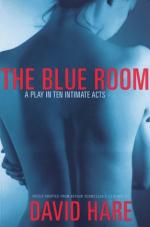|
This section contains 497 words (approx. 2 pages at 400 words per page) |

|
The Blue Room Summary & Study Guide Description
The Blue Room Summary & Study Guide includes comprehensive information and analysis to help you understand the book. This study guide contains the following sections:
This detailed literature summary also contains Bibliography on The Blue Room by David Hare.
When David Hare's The Blue Room opened on Broadway in December, 1998, it became part of a record-setting year for the prolific playwright. In a twelve-month period, the British author managed to send four of his latest plays across the Atlantic to New York's stages. The others included The Judas Kiss, Amy's View, and Hare's one-man autobiographical staged memoir, Via Dolorosa.
The Blue Room is based on Reigen, a series of vignettes written by Dr. Arthur Schnitzler in 1896. Reigen, German for "round dance," was set in Schnitzler's own fin de siecle Vienna and depicted a number of characters in a continuous chain of sexual liaisons, suggesting that the meaningless physical relationships they shared, as well as venereal diseases they picked up along the way, were passed along in a mechanical, dehumanizing chain. When the work was actually performed in Vienna in 1921, it was closed by police for its scandalous sexual content. Actors in a Berlin production the same year were taken to court on obscenity charges. The film version, La Ronde, created by Max Ophuls in 1950, lifted some sense of the taboo surrounding the story and replaced it with a wistful nostalgia and only minor titillation.
In the introduction to his adaptation of the play, Hare claims he first learned about Schnitzler's clever story as a boy, when his father promised him he could one day watch "his favorite film of all time." More recently, it was director Sam Mendes who asked Hare to adapt Schnitzler's work for a modernized stage version. For Hare, who has written many times about deception and dissatisfaction in relationships, the story was a natural draw. "[Schnitzler's] essential subject is the gulf between what we imagine, what we remember, and what we actually experience," the playwright suggests.
In Hare's retelling, the story remains the same, ten characters fall in and out of bed with each other, never quite finding fulfillment but the setting and some of the ideas have changed. No longer Vienna, the backdrop for The Blue Room is described ambiguously as "one of the great cities of the world, in the present day." Although it is not a major issue in the play, AIDS has replaced less harmful venereal diseases as a communicable worry in the minds of some of Hare's characters, and the shock audiences may have experienced upon witnessing a staged sexual roundelay nearly a century ago has turned into curious titillation for New Yorkers interested in seeing a famous film star in the buff (a reference to star Nicole Kidman's nude scene). As critic Charles Isherwood noted in Variety, "At the last turn of the century, when the original was written, it was considered too dangerous to be published and later inspired police action; on the cusp of the next, the new text has become virtually insignificant, lost in the swirl of celebrity hype that has surrounded the production." Seemingly the more things change, the more they stay the same: audiences still flocked to both productions.
Read more from the Study Guide
|
This section contains 497 words (approx. 2 pages at 400 words per page) |

|



